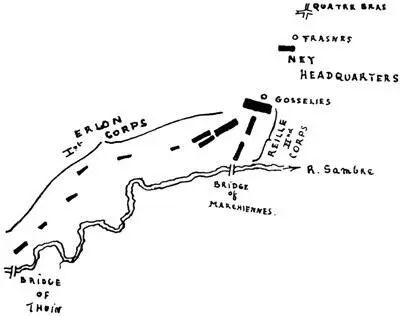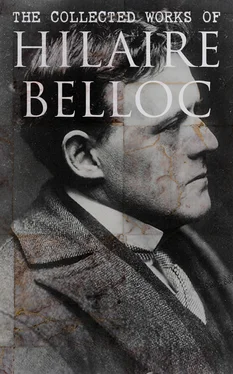To concentrate all those 50,000 men, half of them spread out over so much space, meant a day’s ordinary marching; and one would have thought that Ney should have begun to concentrate before night fell upon the 15th. He remembered, however, that the men were fatigued, he thought he had plenty of time before him, and he did not effect their concentration. The mass of the Second Army Corps (Reille’s) was, as I have said, near Gosselies on the Friday dawn; but Erlon, with the First Army Corps, was not in disposition to bring the bulk of it up by the same time. He could not expect to be near Quatre Bras till noon or one o’clock. But even to this element of delay, due to his lack of precision, Ney added further delay, due to slackness in orders.

It was eleven o’clock on the morning of that Friday the 16th before Ney sent a definite order to Reille to march; it was twelve before the head of that Second Army Corps set out up the great road to cover the four or five miles that separated them from Ney’s headquarters at Frasnes. Erlon, lying next behind Reille, could not advance until Reille’s last division had taken the road. So Erlon, with the First Army Corps, was not in column and beginning his advance with his head troops until after one o’clock.
At about half-past one, then, we have the first troops of Reille’s army corps reaching Ney at Frasnes, its tail-end some little way out of Gosselies; while at the same hour we have Erlon’s First Army Corps marching in column through Gosselies.
It would have been perfectly possible, at the expense of a little fatigue to the men, to have had the Second Army Corps right up at Frasnes and in front of it and deployed for action by nine o’clock, while Erlon’s army corps, the First, coming behind it as a reserve, an equal body in numbers, excellence, and order, would have taken the morning to come up. In other words, Ney could have had more than 20,000 men ready for the attack on Quatre Bras by mid-morning, with as many men an hour or two behind them, and ready on their arrival to act as a reserve. As a matter of fact, he waited with his single battalion and a few horsemen at his headquarters at Frasnes, only giving the orders we have seen, which did not bring Reille’s head columns up to him till as late as half-past one. It was well after two o’clock before Reille’s troops had deployed in front of Frasnes and this Second Army Corps were ready to attack the position at Quatre Bras, which Ney still believed to be very feebly held. The other half of Ney’s command, the First Army Corps, under Erlon, was still far away down the road.
This said, it behoves us to consider the strategical value of the Quatre Bras position, and later to see how far Ney was right in thinking that it was still quite insufficiently furnished with defenders, even at that late hour in the day.
Armies must march by roads. At any rate, the army marching by road has a vast advantage over one attempting an advance across country; and the better kept-up the road the greater advantage, other things being equal, has the army using it over another army debarred from its use.
Quatre Bras is the cross-way of two great roads. The first road is that main road from north to south, leading from the frontier and Charleroi to Brussels; along this road, it was Napoleon’s ultimate intention to sweep, and up this road he was on that morning of the 16th sending Ney to clear the way for him. The second road is the great road east and west from Nivelles to Namur, which was in June 1815 the main line of communication along which the two halves of the Allies could effect their junction.
The invader, then, when he held Quatre Bras, could hold up troops coming against him from the north, troops coming against him from the east, or troops coming against him from the west. He could prevent, or rather delay, their junction. He would have stepped in between.
But Quatre Bras has advantages greater than this plain and elementary strategical advantage. In the first place, it dominates the whole countryside. A patch or knoll, 520 feet above the sea, the culminating point of the plateau, is within a few yards of the cross-roads. Standing there, a few steps to the west of the highway, you look in every direction over a rolling plain, of which you occupy the highest point for some miles around.
Now, this position of the “Quatre Bras” or “Cross Roads” can be easily defended against a foe coming from the south, as were the two corps under Ney. In 1815 its defence was easier still.
A large patch of undergrowth, cut in rotation, called the Wood of Bossu, ran along the high road from Frasnes and Charleroi, flanking that road to the west, and forming cover for troops that might wish to forbid access along it. The ground falls somewhat rapidly in front of the cross-roads to a little stream, and just where the stream crosses the road is the walled farm of Gemioncourt, which can be held as an advanced position, while in front of the fields where the Wood of Bossu once stood is the group of farm buildings called Pierrepont. Finally, that arm of the cross-roads which overlooks the slope down to Gemioncourt ran partly on an embankment which could be used for defence as a ready-made earthwork.
Now, let us see what troops were actually present that Friday morning upon the allied side to defend this position against Ney’s advance, and what others were near enough in the neighbourhood to come up in defence of the position during the struggle.
There was but one division of the Allies actually on the spot. This was the Netherlands division, commanded by Perponcher; and the whole of it, including gunners and sappers (it had hardly any cavalry 8with it), was less than 8000 strong. It was a very small number to hold the extended position which the division at once proceeded to occupy. They had to cover a front of over 3000 yards, not far short of two miles.
They did not know, indeed, what Ney was bringing up against them; Wellington himself, later on, greatly underestimated the French forces on that day. Now even if Ney had had far less men than he had, it was none the less a very risky thing to disperse the division as Perponcher did, especially with no more than fourteen guns to support him, 9but under the circumstances it turned out to be a wise risk to have taken. Ney had hesitated already, and was in a mood to be surprised at any serious resistance. The more extended the veil that was drawn before him, the better for the Allies and their card of delay. For everything depended upon time. Ney, as will be seen, had thrown away his chance of victory by his extreme dilatoriness, and during the day the Allies were to bring up unit after unit, until by nightfall nearly 40,000 men not only held Quatre Bras successfully, but pushed the French back from their attack upon it.
Perponcher, then, put a battalion and five guns in front of Gemioncourt, another battalion inside the walls of the farm, four battalions and a mounted battery before the Wood of Bossu and the farm of Pierrepont. Most of his battalions were thus stretched in front of the position of Quatre Bras, the actual Cross Roads where he left only two as a reserve.
Against the Dutchmen, thus extended, the French order to advance was given, and somewhere between half-past two and a quarter to three the French attack began. It was delivered upon Gemioncourt and the fields to the right or east of the Brussels road.
The action that followed is one simple enough to understand by description, but difficult to express upon a map. It is difficult to express upon a map because it consisted in the repeated attack of one fixed number of men against an increasing number of men.
Читать дальше













